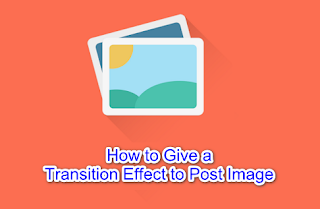How to Give a Transition Effect to Post Image
How to Give a Transition Effect to Post Image - This time I will share a tutorial on tips on how to give a transition effect to post images. The way it works is actually almost the same as in the post Speeding up Loading Blog with AdSense Lazy Load, which is that the content will appear when we scroll the page down.
Immediately, for those of you who want to install it, the method is quite easy. Please refer to the following steps.
As usual, open the Blogger page >> Click the Themes menu and click the Edit HTML button >> Add this CSS code before </head>
Next add the following code before </body>
After that click the Save theme button and finish. And you can see the results on your blog.
Not only limited to giving effect to the image post, you can also modify and effect other parts of a template.
And this version is a little different, the transition effect will still run when scrolling the page up and down.
Add this CSS code before </head>
Next add the following code before </body>
Note : Note the code that is marked, meaning the class "module" is the part that you want to give effect to.
For example if you want to use it in the posting section, just add the "module" class to the postup mark:
Just a few tips that I can share this time about How to Give a Transition Effect to Post Image. Hopefully it can be useful and good luck.
Immediately, for those of you who want to install it, the method is quite easy. Please refer to the following steps.
Giving Effects to Post Images
As usual, open the Blogger page >> Click the Themes menu and click the Edit HTML button >> Add this CSS code before </head>
<b:if cond='data:blog.pageType != "index"'>
<style type='text/css'>
.imgani .post-body img{opacity:0;transition:all .6s ease;transform:scale(.95) translateY(20px)}.imgani .post-body img.anime{opacity:1;transform:scale(1) translateY(0)}
</style>
</b:if>
Next add the following code before </body>
<b:if cond='data:blog.pageType != "index"'>
<script type='text/javascript'>
//<![CDATA[
// Image Transition
var scroll="yes",Fscroll=scroll.replace(/(\r\n|\n|\r)/gm," ");"yes"===Fscroll&&($(document).ready(function(){$("body").addClass("imgani")}),$(window).bind("load resize scroll",function(){var o=$(this).height();$(".post-body img").each(function(){var s=.1*$(this).height()-o+$(this).offset().top;$(document).scrollTop()>s&&$(this).addClass("anime")})}));
//]]>
</script>
</b:if>
After that click the Save theme button and finish. And you can see the results on your blog.
Not only limited to giving effect to the image post, you can also modify and effect other parts of a template.
And this version is a little different, the transition effect will still run when scrolling the page up and down.
Add this CSS code before </head>
<style type='text/css'>
.come-in{perspective:200px;animation:hago 0.8s ease forwards}
.already-visible{left:0;animation:none}
@keyframes hago{from{opacity:.5;transform:scale(0.8)}to{opacity:1;transform:scale(1.0)}}
</style>
Next add the following code before </body>
<script type='text/javascript'>
//<![CDATA[
// Transition
!function(t){var o=t(window);t.fn.visible=function(i,e,r,f){if(!(this.length<1)){r=r||"both";var n=this.length>1?this.eq(0):this,l=void 0!==f&&null!==f,h=l?t(f):o,g=l?h.position():0,u=n.get(0),p=h.outerWidth(),s=h.outerHeight(),b=!0!==e||u.offsetWidth*u.offsetHeight;if("function"==typeof u.getBoundingClientRect){var a=u.getBoundingClientRect(),c=l?a.top-g.top>=0&&a.top=0&&a.top0&&a.bottom<=s+g.top:a.bottom>0&&a.bottom<=s,d=l?a.left-g.left>=0&&a.left=0&&a.left0&&a.right0&&a.right<=p,w=i?c||v:c&&v,y=i?d||m:d&&m;w=a.top<0&&a.bottom>s||w,y=a.left<0&&a.right>p||y;if("both"===r)return b&&w&&y;if("vertical"===r)return b&&w;if("horizontal"===r)return b&&y}else{var z=l?0:g,B=z+s,C=h.scrollLeft(),H=C+p,R=n.position(),W=R.top,j=W+n.height(),q=R.left,L=q+n.width(),Q=!0===i?j:W,k=!0===i?W:j,x=!0===i?L:q,A=!0===i?q:L;if("both"===r)return!!b&&k<=B&&Q>=z&&A<=H&&x>=C;if("vertical"===r)return!!b&&k<=B&&Q>=z;if("horizontal"===r)return!!b&&A<=H&&x>=C}}}}(jQuery);
// Transition Option
var win=$(window),allMods=$(".module");allMods.each(function(l,i){$(i).visible(!0)&&$(i).addClass("already-visible")}),win.scroll(function(l){allMods.each(function(l,i){(i=$(i)).visible(!0)?i.addClass("come-in"):i.removeClass("come-in already-visible")})});
//]]>
</script>
Note : Note the code that is marked, meaning the class "module" is the part that you want to give effect to.
For example if you want to use it in the posting section, just add the "module" class to the postup mark:
<div class='main-wrapper'>
<div id='post' class='post module'></div>
</div>
Just a few tips that I can share this time about How to Give a Transition Effect to Post Image. Hopefully it can be useful and good luck.

Post a Comment for "How to Give a Transition Effect to Post Image"
Provide comments relevant to the posted articles and provide critiques and suggestions for the progress of the blog